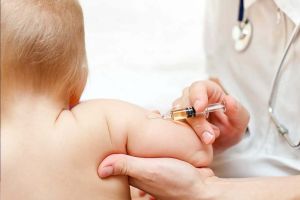6-in-1 Vaccine
6-in-1 Vaccine
What you need to know
about the 6-in-1 Vaccine
One of the first vaccines your infant will receive is the 6-in-1 vaccine.
It’s a simple injection that protects your child from six serious childhood illnesses:
- Diphtheria
- Hepatitis B
- Hib (Haemophilus influenzae type b)
- Polio
- Tetanus
- Whooping cough (pertussis)
When should babies get the 6-in-1 vaccine?
When babies are 8, 12, and 16 weeks old, they receive the 6-in-1 immunisation.
They will require three doses to establish good protection against the diseases that the vaccine protects them from.
Your baby’s immune response improves with each additional dosage of the vaccine.
How is the 6-in-1 vaccine administered?
The 6-in-1 vaccine is injected into your baby’s thigh.
How effective is the 6-in-1 vaccine?
The 6-in-1 vaccine is effective. It provides excellent protection against diphtheria, tetanus, whooping cough, Hib, polio, and hepatitis B.
6-in-1 vaccination protection
The six-in-one vaccine is quite safe. It’s killed (inactivated), which means it doesn’t contain any living organisms, so your kid won’t acquire the disease through the vaccine.
The 6-in-1 vaccine’s side effects
The 6-in-1 vaccine is quite safe, but some babies can experience negative effects, as with any treatment. The majority of adverse effects are minor and temporary. The majority of newborns will have no issues.
The following are some common reactions:
- Where the injection was given, there was discomfort, redness, and swelling.
- A hot environment (more common after the 2nd and 3rd doses).
- Being unwell.
- Irritability.
- A decrease in appetite.
Rare adverse effects of the 6-in-1 immunisation include unusually high-pitched sobbing, fits, or convulsions.
After receiving the 6-in-1 vaccine, a baby may experience a severe allergic reaction (anaphylaxis).
Learn more about the adverse effects of the 6-in-1 vaccine.
Infanrix hexa (DTaP/IPV/Hib/HepB) is the brand name for the 6-in-1 vaccine. On the electronic medications compendium website, read the patient information sheet for Infanrix hexa.
Reactions to the 6-in-1 immunisation are rather common.
The following are the most common side effects recorded after the 6-in-1 immunisation, which affect up to 1 in 10 babies:
- At the injection site, there is discomfort, redness, and swelling.
- Fever (temperature exceeding 38°C) – occurs more frequently after the second and third doses.
- Vomiting
- Unusual crying
- Irritability
- A decrease in appetite
Rare side effects
Other possible adverse effects, which have been recorded in fewer than 1 in 10,000 newborns, include:
- Crying that is unusually loud and high-pitched
- Seizures or fits
Allergic reaction
A severe allergic reaction (anaphylaxis) in a neonate following the 6-in-1 immunisation is extremely unusual. This occurs in less than one in 100,000 cases and can occur with any immunisation.
Although anaphylaxis is a serious medical condition, all immunisation workers are trained to handle anaphylactic responses on the scene. Babies that are treated quickly make a full recovery.
What should you do if your child has a fever? (high temperature)
If your child gets a fever (high temperature) after receiving the 6-in-1 vaccine, keep them cool by doing the following:
- Ensuring that they are not wearing too many layers of clothing or blankets
- Provide more drinks are being offered (if you are breastfeeding, your child may feed more often)
To lower their temperature, you could also give them infant paracetamol. Learn more about children’s drugs.
If your baby’s temperature rises above 38 degrees Celsius, call your doctor’s surgery or dial 111.
What should you do if your child has a major side effect?
If your baby is severely sick or you have any concerns about their health after a vaccination, see a doctor.
If your baby experiences a seizure or any other significant medical problem after returning home from the immunisation, call your doctor or 999 for an ambulance.
Seizures can be frightening for babies, but they normally pass quickly.
Consult your doctor, practice nurse, or health visitor if you have concerns about your baby’s reaction to a previous dose of the 6-in-1 vaccine.
Monitoring safety of the 6-in-1 vaccine
The Medicines and Healthcare Products Regulatory Agency (MHRA) and the Commission on Human Medicines in the United Kingdom monitor vaccination safety through the Yellow Card Scheme.
The majority of reactions to the 6-in-1 vaccines reported through the Yellow Card Scheme were minor, such as a rash, fever, vomiting, redness, or swelling at the injection site.
Vaccines such as the 6-in-1 vaccine and others
The 6-in-1 vaccination can be given to your kid at the same time as other immunizations such the rotavirus vaccine, pneumococcal vaccine, and MenB vaccine.
If you miss your 6-in-1 immunisation appointment
It’s great if your child gets the 6-in-1 vaccine at the recommended age to prevent them from dangerous diseases as soon as possible.
It’s never too late to get your baby the 6-in-1 immunisation if you’ve missed an appointment. Make an appointment at your local GP’s surgery or a local child health centre.
Infants who should not receive the 6-in-1 immunisation
The 6-in-1 vaccine is safe for most babies, however, there are a few who shouldn’t get it, such as those who:
- Are hypersensitive to the vaccination
- If they have a fever at the time of their immunisation appointment, they should wait until they’ve recovered.
- Having a neurological condition that is worsening, such as poorly controlled epilepsy – wait until they’ve been examined by a professional.
Babies who have had a severe allergic reaction (anaphylaxis) to a previous dose of the vaccination, or a reaction to any portion of the vaccine that may be present in trace levels, such as neomycin, streptomycin, or polymyxin B, should not receive the 6-in-1 vaccine.
If your kid has a small sickness, such as a cough or a cold without a temperature, there’s no reason to delay vaccination.
Consult your GP surgery, nurse, or health visitor if your baby has a history of fits (febrile convulsions) or has had a fit within 72 hours of receiving a previous dose of the vaccination.


